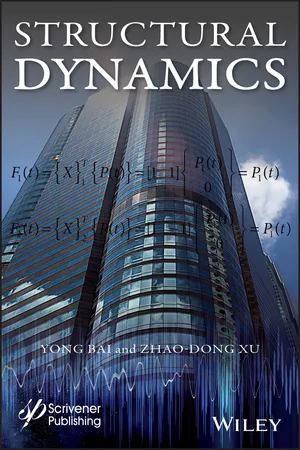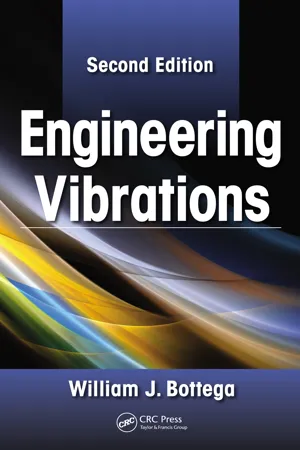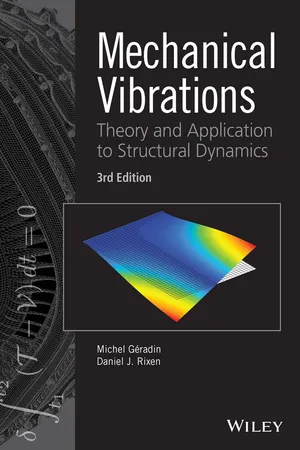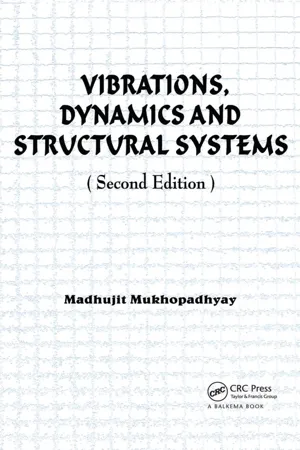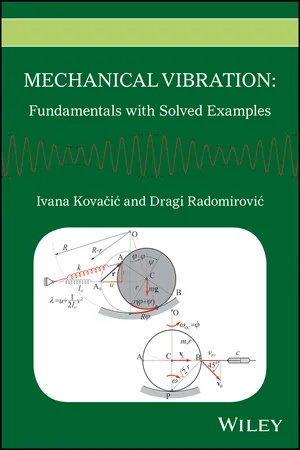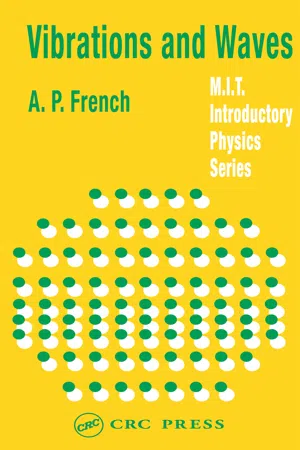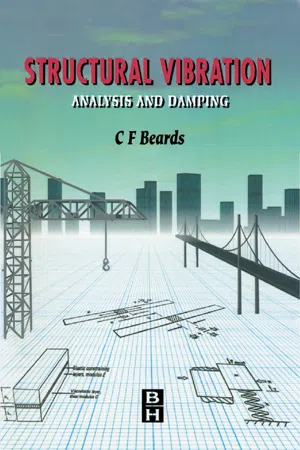Technology & Engineering
Undamped Free Vibration
Undamped free vibration refers to the oscillation of a system without any external damping or resistance. In this type of vibration, the amplitude remains constant, and the system continues to oscillate indefinitely. It is characterized by a constant frequency and does not lose energy over time. Undamped free vibration is a fundamental concept in the study of mechanical and structural engineering.
Written by Perlego with AI-assistance
Related key terms
Related key terms
1 of 4
Related key terms
1 of 3
11 Key excerpts on "Undamped Free Vibration"
- eBook - ePub
Engineering Dynamics
Fundamentals and Applications
- M Rashad Islam, A K M Monayem H Mazumder, Mahbub Ahmed(Authors)
- 2022(Publication Date)
- CRC Press(Publisher)
7 Vibration DOI: 10.1201/9781003283959-7 7.1 General Mechanical vibration, or simply vibration, is the measurement of periodic oscillations with respect to an equilibrium condition of an object. Sometimes, vibrations are desirable in certain types of machine tools or production lines. However, most of the time, vibration of mechanical systems is not desirable due to wasting energy, reducing efficiency, and safety considerations. For example, passenger ride comfort in aircraft or automobiles is greatly affected by the vibrations caused by outside disturbances, such as aero-elastic effects or rough road conditions. In other cases, eliminating vibrations may save human lives; a good example of this is the vibration of civil engineering structures during an earthquake. Vibrations can be classified as: (a) Free and Forced Vibration. Free vibration means the system is left to vibrate on its own after the initial disturbance. In forced vibration, the system is subjected to an external repeating type of force, and the system vibrates in response to that. (b) Damped and Undamped. If no energy is lost or dissipated by friction or other resistance during oscillation, the vibration is known as undamped vibration. If any energy is lost in this way, it is called damped vibration. In many physical systems, the amount of damping is so small that it can be disregarded for most engineering purposes. (c) Linear and Nonlinear. If all the basic components of a vibration system such as spring, mass, and the damper behave linearly, then it is called linear vibration. In nonlinear vibration, one or more basic components of a vibration system do not behave in a linear manner. (d) Deterministic or Not. Deterministic means the magnitude of the excitation (force or motion) acting on a vibratory system is known at any given time. In random vibration, the value of the excitation at any given time cannot be predicted - eBook - ePub
- Yong Bai, Zhao-Dong Xu(Authors)
- 2019(Publication Date)
- Wiley-Scrivener(Publisher)
Finally, this chapter will end with the discussion of damping, vibration energy, vibration measurement, and the principle of vibration isolation. 3.1 Response of Free Vibrations Chapter 2 has discussed how to establish the motion differential equation of dynamic systems. As is shown in Figure 3.2 (as example 2.1), the equation of motion for this SDOF system is found to be (3.1) Figure 3.2 To simplify a complex structure. Structural free vibration is a vibrational process in which the structure leaves the equilibrium position when disturbed and no longer affected by any external force, i.e., P (t)=0, and the equation of motion will be (3.2) When the dynamical system has the damping term, which means the system has an energy dissipation mechanism, the reaction of the dynamic system will be influenced directly. The SDOF system without damping is called the undamped SDOF system, while the one that has damping is termed the damped SDOF system. Free vibration of the undamped SDOF system will be introduced first. 3.1.1 Undamped Free Vibrations For the undamped SDOF system, c = 0, according to the Eq. (3.2), the motion equation of the structure can be expressed as (3.3) Assuming the solution is in the following form (3.4) Where s is undetermined constant and A is constant coefficient. Substituting Eq. (3.4) into Eq. (3.3) leads to (3.5) It is evident that the two eigenvalues of Eq. (3.5) are s 1 = iω n and s 2 = – iω n. Adopting the notation of, which is a constant parameter related to the properties of the structure. Utilizing the relationship between exponential function and trigonometric function of e ix = cos x + i sin x and e –ix = cos x – i sin x, solutions of Eq. (3.4) may be expressed by sine function and cosine function in the following form (3.6) In this formula, A and B are two new undetermined constants which will be confirmed by the initial conditions of the system of A = u (0) - eBook - ePub
- William J. Bottega(Author)
- 2014(Publication Date)
- CRC Press(Publisher)
Free Vibration of Single Degree of Freedom SystemsThe most fundamental system germane to the study of vibrations is the single degree of freedom system. By definition (see Section 1.1 ), a single degree of freedom system is one for which only a single independent coordinate is needed to describe the motion of the system completely. It was seen in Chapter 1 that, under appropriate circumstances, many complex systems may be adequately represented by an equivalent single degree of freedom system. Further, it will be shown in later chapters that, under a certain type of transformation, the motion of discrete multi-degree of freedom systems and continuous systems can be decomposed into the motion of a series of independent single degree of freedom systems. Thus, the behavior of single degree of freedom systems is of interest in this context as well as in its own right. In the next few chapters the behavior of these fundamental systems will be studied and basic concepts of vibration will be introduced.2.1 Free Vibration of Undamped Systems
The oscillatory motion of a mechanical system may be generally characterized as one of two types, free vibration or forced vibration. Vibratory motions that occur without the action of external dynamic forces are referred to as free vibrations, while those resulting from dynamic external forces are referred to as forced vibrations. In this chapter we shall study free vibrations of single degree of freedom systems. We first establish the general form of the equation of motion and its associated solution.2.1.1 Governing Equation and System Response
It was seen in Chapter 1 that many mechanical systems can be represented as equivalent single degree of freedom systems and, in particular, as equivalent mass-spring systems. Let us therefore consider the system comprised of a mass m attached to a linear spring of stiffness k that is fixed at one end, as shown in Figure 2.1 . Let the mass be constrained so as to move over a horizontal frictionless surface, and let the coordinate x measure the position of the mass with respect to its rest configuration, as indicated. Thus, x = 0 corresponds to the configuration of the horizontally oriented system when the spring is unstretched. We wish to determine the motion of the mass as a function of time, given the displacement and velocity of the mass at the instant it is released. If we let the parameter t represent time, we will know the motion of a given system if we know x(t) for all times of interest. To accomplish this, we must first derive the equation of motion that governs the given system. This is expedited by examination of the dynamic free-body diagram (DFBD) for the system, also known as the kinetic diagram, depicted in Figure 2.2 . In that figure, the applied force acting on the system (the cause) is shown on the left-hand side of the figure, and the inertia force (the response) is shown on the right-hand side of the figure. The kinetic diagram is simply a pictorial representation of Newton’s Second Law of Motion and, as was seen in Section 1.5 , greatly aids in the proper derivation of the governing equations for complex systems. In Figure 2.2 , and throughout this text, we employ the notation that superposed dots imply (total) differentiation with respect to time (i.e., x ≡ dx/dt - eBook - ePub
Mechanical Vibrations
Theory and Application to Structural Dynamics
- Michel Geradin, Daniel J. Rixen(Authors)
- 2014(Publication Date)
- Wiley(Publisher)
Chapter 2 Undamped Vibrations of n-Degree-of-Freedom SystemsFrom the theory and examples discussed in Chapter 1 one should remember that the description of the dynamics of a mechanical system as obtained from Hamilton's principle, from the Lagrange equations or from the principle of virtual work generally leads to a set of nonlinear equations. Solving such nonlinear equations usually requires applying time-integration techniques as those described later in Chapter 7. Nevertheless, for many practical applications, dynamical behaviour manifests itself only as time-varying perturbation around a static solution. Indeed systems can often be described as being in an statical equilibrium configuration, around which they undergo only small dynamic motion, namely vibrations.In that case, the description of the system can be significantly simplified and a linearization around an equilibrium position of the generally nonlinear dynamic equations is possible. Although such a linear description is valid only for small perturbations, it is an essential step in grasping fundamental concepts in mechanical vibrations such as stability, eigenfrequencies and eigenmodes. The mathematical tools available to theoretically investigate the vibration of systems is rich and versatile, allowing scientists and engineers to build fundamental understanding of dynamical problems.In this chapter only systems without dissipative forces are considered (dissipative systems will be the subject of Chapter 3). We will first define the concept of equilibrium position and vibration, discussing both the cases when the equilibrium position corresponds to a truly static configuration and when it has to be understood as an overall steady motion (Section 2.1). In particular we outline how the linear form can be obtained from the energy description underlying the Lagrange equations, allowing us to express the vibration behaviour in a matrix form exhibiting symmetry for the stiffness and mass contributions, and skew-symmetry for the gyroscopic part resulting from overall transport motion. - eBook - ePub
- Bikash C. Chakraborty, Debdatta Ratna(Authors)
- 2020(Publication Date)
- Elsevier(Publisher)
Fig. 1.8 depicts the nature of the decay, which is an exponential curve having no sinusoidal component.Fig. 1.8 Free vibration of an SDOF system, undamped and critically damped.1.5.2.3 Case (3)—Overdamped system
The vibration response is overdamped when the damping factor is > 1, that is, λ /λ C or ξ > 1. The solution to Eq. (1.12) can beut=C 1exp+− ξ +1 −ξ 2ω ntC 2− ξ −1 −ξ 2ω nt(1.21)where C 1 and C 2 are the coefficients of integration and can be found out by solving the equation using initial conditions u 0 and v 0 . The solution becomesu t =expu 0ω nξ ++ξ 2− 1v 02ω nξ 2− 1+− ξ +ξ 2− 1ω ntexp−u 0ω nξ −−ξ 2− 1v 02ω nξ 2− 1− ξ −ξ 2− 1ω nt(1.22)This is also a uniform exponential decay curve without any vibration characteristics. A typical response curve is given in Fig. 1.9 . Example of an underdamped system is common, including cured rubber bushes and mounts, while a typical example of an overdamped system is the unvulcanised butyl rubber latex.Fig. 1.9 Overdamped SDOF system in free vibration, compared with undamped and critically damped systems.1.5.3 Forced vibration
When an external oscillatory excitation force is applied onto a body, the resulting vibration is termed as forced vibration. In the event of a frequency sweep by an external exciter, when the sweeping frequency coincides with that of the natural frequency of the system, the phenomenon is called resonance and at that point, the amplitude of vibration would be maximum. In a random vibration, such as a running turbine, there can be many subsequent higher modes.1.5.3.1 Frequency response in undamped forced vibration
Let F 0 sin(ωt - C. Beards(Author)
- 1995(Publication Date)
- Butterworth-Heinemann(Publisher)
Other motions may occur, but they are assumed to be negligible compared to the coordinate considered. A system with one degree of freedom is the simplest case to analyse because only one coordinate is necessary to completely describe the motion of the system. Some real systems can be modelled in this way, either because the excitation of the system is such that the vibration can be described by one coordinate although the system could vibrate in other directions if so excited, or the system really is simple, as for example a clock pendulum. It should also be noted that a one degree of freedom model of a complicated system can often be constructed where the analysis of a particular mode of vibration is to be carried out. To be able to analyse one degree of freedom systems is therefore an essential ability in vibration analysis. Furthermore, many of the techniques developed in single degree of freedom analysis are applicable to more complicated systems. 2.1 FREE UNDAMPED VIBRATION 2.1.1 Translation vibration In the system shown in Fig. 2.1 a body of mass m is free to move along a fixed horizontal surface. A spring of constant stiffness k which is fixed at one end is attached at the other end to the body. Displacing the body to the right (say) from the equilibrium position causes a spring force to the left (a restoring force). Upon release this force gives the body an acceleration to the left. When the body reaches its equilibrium position the spring force is zero, but the body has a velocity which carries it further to the left although it is retarded by the spring force which now acts to the right. When the body is arrested by the spring the spring force is to the right so that the body moves to the right, past its equilibrium position, and hence reaches its initial displaced position. In practice this position will not quite be reached because damping in the system will have dissipated some of the vibrational energy- Madhujit Mukhopadhyay(Author)
- 2023(Publication Date)
- CRC Press(Publisher)
Fig. 2.3(b) . Again in the machine, the forces that act are the inertia force, the spring force, the damping force and the external force.From the above examples it is seen, that for studying the vibration of any system, the following are the four elements of importance:Fig. 2.3. A spring mounted machine and its freebody- (a) The inertia force,
- (b) The damping force,
- (c) The restoring force, and,
- (d) The exciting force.
If the external force is zero, the resulting vibration is called the free vibration. In such cases, if damping is present in the system, it is called free damped vibration and if damping is absent in the system, it is called free undamped vibration.The two systems mentioned above, can be idealised in the form of spring-mass system as shown in Fig. 2.4 . All structures can be reduced to systems consisting of combinations of springs, masses and dashpots and is an idealisation in a convenient form of the actual structure.Fig. 2.4. A spring-mass- dashpot systemThe only independent coordinate of the spring-mass system of Fig. 2.4 is the x-directional translation and the displacement will simply be given by x, velocityApplying D’Alembert’s principle and considering equilibrium of all the forces in the x-direction, the general equation of motion for the SDF system isand accelerationx ˙(=)d xd t. The inertia force of the mass is mẍ, the damping force is cẋ and the spring force is kx. The external force acting on the system is F(t).x ¨(=)d 2xdt 2
The solution of Eq. (2. 1) gives the response of the mass to the applied force in the SDF system.mx ¨+ cx ˙+ k x = F ( t )(2.1) 2.3 Free Undamped Vibration of the SDF System
When the case of free undamped vibration is considered, F (t) = 0 and c- eBook - ePub
- Juan Carlos A. Jauregui Correa, Alejandro A. Lozano Guzman(Authors)
- 2020(Publication Date)
- Academic Press(Publisher)
Among the concepts presented in this chapter, the definition of mechanical vibrations will be divided into deterministic and random vibrations. The deterministic vibrations represent regular movements whose waveform can be known in time, whereas random vibrations do not repeat regularly. However, this chapter presents the fundamentals of the study of the mechanical vibration, considering that they are deterministic, suggesting that the movement is harmonic, that is, that it regularly repeats in time.Random vibrations are usually found in the vibration analysis for conditioning monitoring. However, through spectral analysis techniques, random signals are studied by applying the defined concepts for the harmonic vibrations.In order to analyze the vibratory phenomena, it is necessary to represent the movements so that the characteristics of the vibrations can be identified as either deterministic or random. The simplest representation of a machine is made by idealizing its vibratory movements as a mass in motion supported by a spring and a viscous damper (Fig. 1.1 ). The mass is considered a single particle and the spring is considered an element that obeys Hook's law, where k is the stiffness constant of the spring, m is the mass of the particle, and the viscous constant c is the damping of this movement. The force generated by oscillating this spring is given by F r = kx , where x is the displacement that the mass m suffers. The force generated by this damper is given by F a = cv , where c is the damping coefficient and v is the speed of the mass motion m . The external forces applied to the mechanical system formed by the mass, the spring, and the damper are represented by F (t ).Fig. 1.1 Conceptual model of the vibratory system.The equation of motion is obtained by considering Newton's second law F = ma and the sum of forces acting on the mass m . For this case, the acting forces are those shown in Fig. 1.2 , having:− kx − cv + Ft− mg +F est= ma(1.1)Fig. 1.2 - eBook - ePub
Mechanical Vibration
Fundamentals with Solved Examples
- Ivana Kovacic, Dragi Radomirovic(Authors)
- 2017(Publication Date)
- Wiley(Publisher)
3 Free Undamped Vibration of Single‐Degree‐of‐Freedom SystemsChapter Outline
This chapter starts with a brief preview of Lagrange’s equation for free undamped vibration, both the exact one and the approximated one for small oscillations around a stable equilibrium. Fifteen examples are then solved in detail, showing how the equations of motion can be obtained in either of these approaches. Special attention is given to the potential energy (especially when the spring is predeformed) as well as to the way that the kinetic energy can be obtained more easily by considering the position when the system passes through the equilibrium position.Chapter Objectives
- To present Lagrange’s equation of the second kind for free undamped vibration
- To illustrate a variety of examples in which it yields the equation of motion
- To demonstrate the importance of the prestress of a spring for its potential energy
- To describe in detail how the potential energy of a spring can be determined by considering its deformations in two orthogonal directions
- To demonstrate how the kinetic energy can be obtained more easily by considering the position when the system passes through the equilibrium position
Theoretical Introduction
Free oscillations occur when a mechanical system is set in motion with an initial input (initial displacement and/or initial velocity). The corresponding equation of motion can be obtained by using Lagrange’s equation of the second kind. Its form for a one‐degree‐of‐freedom free conservative systems is - eBook - ePub
- A.P. French(Author)
- 2017(Publication Date)
- CRC Press(Publisher)
Acoustics (Blackie & Son, London, 1940): “It seems difficult to believe that legislation should be designed to cover a situation that had never arisen.” The example does seem rather bizarre, however, and H. Bouasse, the French physicist who drew attention to this Talmudic pronouncement, reported that he had himself reared a large number of cocks, none of which developed a habit of putting their heads inside glass vases!To provide some initial feeling for the theoretical description of the resonance phenomenon, without getting too involved with analytical details, we shall begin by considering the simple though physically unreal case of an oscillator in which the damping effect is entirely negligible.Undamped Oscillator with Harmonic Forcing
We shall take our system to be the usual mass m on a spring of spring constant k . To this we shall imagine the application of a sinusoidal driving force F = F 0 cos ωt . The value of √k/m , representing the natural angular frequency of the system, will be denoted by ω0 . Then the statement of the equation of motion, in the form ma = net force, ismor= − k x +d 2xdt 2F 0cos ω tm+ k x =d 2xdt 2F 0cos ω t( 4.1 )Before we discuss this differential equation of motion in detail, let us consider the situation qualitatively. If the oscillator is driven from its equilibrium position and then left to itself, it will oscillate with its natural frequency ω 0 . A periodic driving force will, however, try to impose its own frequency1 ω on the oscillator. We must expect, therefore, that the actual motion in this case is some kind of a superposition of oscillations at the two frequencies ω and ω0 . The mathematically complete solution of Eq. (4-1) is indeed a simple sum of these two motions. But because of the inevitable presence of dissipative forces in any real system, the free oscillations will eventually die out. The initial stage, in which the two types of motion are both prominent, is called the transient . After a sufficiently long time, however, the only motion in effect present is the forced oscillation, which will continue undiminished at the frequency ω - eBook - ePub
Structural Vibration
Analysis and Damping
- C. Beards(Author)
- 1996(Publication Date)
- Butterworth-Heinemann(Publisher)
The vibration of some structures can be analysed by considering them as a one degree or single degree of freedom system; that is, a system where only one coordinate is necessary to describe the motion. Other motions may occur, but they are assumed to be negligible compared with the coordinate considered.A system with one degree of freedom is the simplest case to analyse because only one coordinate is necessary to describe the motion of the system completely. Some real systems can be modelled in this way, either because the excitation of the system is such that the vibration can be described by one coordinate, although the system could vibrate in other directions if so excited, or the system really is simple as, for example, a clock pendulum. It should also be noted that a one, or single degree of freedom model of a complicated system can often be constructed where the analysis of a particular mode of vibration is to be carried out. To be able to analyse one degree of freedom systems is therefore essential in the analysis of structural vibrations. Examples of structures and motions which can be analysed by a single degree of freedom model are the swaying of a tall rigid building resting on an elastic soil, and the transverse vibration of a bridge. Before considering these examples in more detail, it is necessary to review the analysis of vibration of single degree of freedom dynamic systems. For a more comprehensive study see Engineering Vibration Analysis with Application to Control Systems by C. F. Beards (Edward Arnold, 1995 ). It should be noted that many of the techniques developed in single degree of freedom analysis are applicable to more complicated systems.2.1 FREE UNDAMPED VIBRATION
2.1.1 Translation vibrationIn the system shown in Fig. 2.1 a body of mass m is free to move along a fixed horizontal surface. A spring of constant stiffness k
Index pages curate the most relevant extracts from our library of academic textbooks. They’ve been created using an in-house natural language model (NLM), each adding context and meaning to key research topics.
Explore more topic indexes
Explore more topic indexes
1 of 6
Explore more topic indexes
1 of 4

